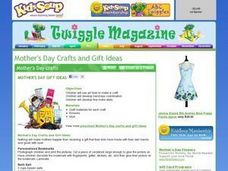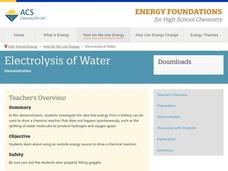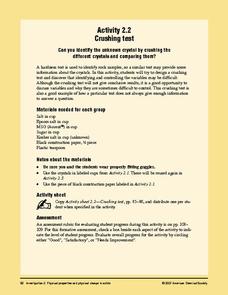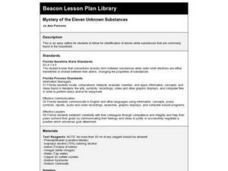Curated OER
Crystal Ice Art
This isn't just an art instructional activity, it's a science instructional activity too. Kids draw a lovely winter scene and then paint over it with a solution of epsom salts and water. They make predictions, then observe how crystals...
Curated OER
Watching Crystals Grow
Students observe crystal growth of Epsom salts and the variables that hinder or help their nucleation and growth. They illustrate a series of drawings/pictures as the crystals grow. They look for the different shapes they form as well...
Curated OER
Formula of a Hydrate Lab
In this hydrate worksheet, students find the formula of an unknown salt by determining the mass of water in the heated compound. Students burn off the water and record data to establish the final mass and formula of the hydrate.
Smithsonian Institution
Watching Crystals Grow
Amazing science can sometimes happen right before your eyes! The class gets cozy as they watch crystals grow. They use Epsom salts, rocks, and food coloring to create crystals. They'll observe the entire process, documenting every step...
Curated OER
A Special Present
Students conduct an experiment to create a special gift. In this special gift lesson plan, students make a gift for someone using water, Epsom salt, essential oil and food coloring. Students can create a card to go with their present.
Curated OER
Chemical Changes
Fourth graders examine and identify chemical and physical changes in a variety of substances. They observe a vinegar and baking soda demonstration, and a water, laundry detergent, and Epsom salt mixture demonstration. They discuss the...
Curated OER
Nature's Polyhedrons
Students are introduced to polyhedrons through using straw models to explore geometric solids and constructing Christmas tree ornaments using Epsom salt crystals. Students will view interactive videos and investigate and retrieve...
American Chemical Society
Using Dissolving to Identify an Unknown
There is a solvent called aqua regis that can dissolve gold! After observing a solubility demonstration, groups receive four known crystals and one unknown. Based on the demo, they design an experiment to determine the identity of the...
Curated OER
Mother's Day Gift Ideas
Students develop their fine motor skills as they make a craft for Mother's Day. In this crafts lesson, students make a craft including bookmarks, coupon books, cards, bath salts, and magnets.
American Chemical Society
Formation of a Precipitate
Conclude this chemical change unit by having your class combine two liquids that result in formation of a precipitate. The learners discover that chemical reactions result in new materials. Make sure to consider all of the preceding...
American Chemical Society
Curious Crystals
Crystals are more than meets the eye! Can learners tell them apart simply by observation? As they examine five samples with a magnifier, they find that appearance alone is not enough. This serves as an introduction to a mini unit on...
American Chemical Society
Electrolysis of Water
Young scientists know that water is H2O, but can they prove it? Through a simple electrolysis of water demonstration, scholars see the two gases produced as a result of a chemical reaction. Because this reaction doesn't happen...
American Chemical Society
Crushing Test
Solidify understanding of the properties of crystals by crushing them to compare hardness. After some class discussion, a procedure is planned, and then small groups go about making observations as they crush five different crystal...
Exploratorium
Indicating Electrolysis
Sure, your learners know water is made up of two molecules, but watching them separate helps the class see the construction like never before. This resource provides directions on how to build a simple electrolysis device using a...
Curated OER
Growing Crystals from Solutions
Students grow crystals in the lab using solutions. In this crystals lesson plan, students set up a crystal growing apparatus using a sugar solution with a thread attached to a piece of copper wire that is inserted in the solution....
Curated OER
Crystal Painting
Students investigate crystalline solids. In this crystals lesson, students observe samples of natural crystals and compare and contrast each. They draw pictures with crayons and then paint over their picture using crystalline solids...
Curated OER
Mummy Dearest
Learners assess what environmental conditions best contribute to preservation and mummification by participating in a multi-day 'apple mummification' lab.
Curated OER
Roald Dahl Quiz
In this Roald Dahl worksheet, students answer twenty questions about this author and his children's books. Students are encouraged to use research skills to find the answers. All answers are printed at the bottom of the worksheet.
Curated OER
Crystals
Students investigate patterns in solids, the structures of crystals and rocks made up of minerals. For this crystals lesson plan, students review solids, make patterns with Styrofoam balls, make crystals in the lab and observe their...
Curated OER
Equilibrium: What Is It?
Tenth graders investigate chemical, physical and mechanical equilibrium. In this equilibrium lesson, 10th graders participate in a physical activity to show equilibrium by some students standing and some students sitting at the same...
Curated OER
Moles, Stoichiometry, and Concentration
In this stoichiometry worksheet, students practice calculating moles, molar mass, and percentage composition of given compounds. This worksheet has 55 problems to solve.
Curated OER
Mixtures
Sixth graders experiment with mixtures. For this chemistry lesson, 6th graders determine which mixtures are considered heterogeneous, a suspension, a solution or a colloid. Students create a data sheet of what they discover.
Curated OER
Mystery of the Eleven Unknown Substances
Fourth graders identify eleven white substances that are commonly found in the household. They, in pairs, perform experiments on a variety of substances, and must identify them based on the reactions they observe.
Curated OER
Polarization
Eighth graders study the basic facts of polarization. In this light waves lesson students demonstrate some activities illustrating interference patterns.

























